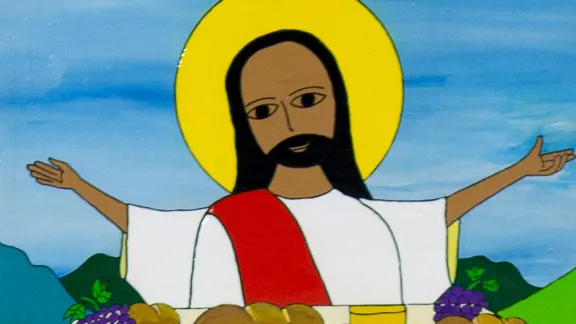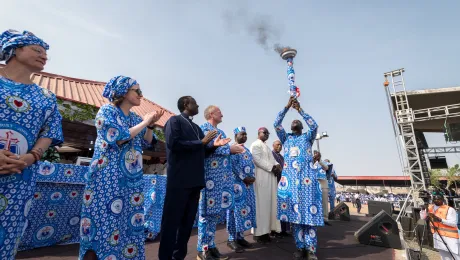
Detail of the cross created for the Reformation commemoration by artist Christian ChavarrÃa Ayala. Photo: LWF
Depicting the Triune God’s creative, reconciling and sanctifying work
Salvadoran artist Christian Chavarria has created a vibrant 2m-high cross for the joint Reformation commemoration, replete with meaning for both Catholics and Lutherans. Dirk Lange, seconded to the LWF as worship coordinator for the Twelfth Assembly and ecumenical commemoration of the 500th anniversary, says the significance of the design lies in its depiction of God’s creative and sanctifying work. Here, he explains the detail of the cross design, drawing on the document From Conflict to Communion.
The cross depicts the Triune God’s creative, reconciling and sanctifying work. At the base of the cross, the hands of God hold all things together, as is recorded in Colossians 1:17 and Hebrews 1:3.
Jesus Christ, Word of God, is at the center of all life, incarnate, redeeming, reconciling, sustaining all creation, and renewing our lives by his death and resurrection made present in the Eucharist. The vineyard and the vine represent both Christ and the people of God.
“Just as the branch cannot bear fruit by itself unless it abides in the vine, neither can you unless you abide in me. I am the vine, you are the branches” (John 15:1-5).
Salvation through a sure promise
The Holy Spirit as dove signifies God’s work of salvation through a sure and certain promise of his redeeming presence among us until he comes again. In the waters of the font, the baptized have been made new and become part of the one body of Christ, the communion of saints.
“The church is the body of Christ. As there is only one Christ, so also he has only one body. Through baptism, human beings are made members of this body” (From Conflict to Communion, paragraph 219).
The Eucharist represents the visible and full church communion for which we dearly long. At the table, our Lord Jesus Christ offers himself as nourishment for the journey, strengthening the communion of saints established in baptism, reconciling all people as walls of division are broken down.
“For Lutherans, as well as Catholics, the Lord’s Supper is a precious gift in which Christians find nourishment and consolation for themselves, and where the church is ever anew gathered and built up” (From Conflict to Communion, par 140). The cross depicts our deepest longing for a shared Eucharist.
Just as Christ takes upon himself our burden and sin so, too, must we for each other. The poor and oppressed are to be cared for and the refugee welcomed. In common witness and service to God and neighbor, we must continuously let ourselves “be transformed by the encounter with the other and by the mutual witness of faith” (From Conflict to Communion, par 240 Second Imperative).
God calls communities of faith to be places of reconciliation
All actions and symbols in this image point to Christ - his life, death and resurrection. The arms of the faithful are raised in thanksgiving for what God is doing.
The fish, too, point to Christ. In Greek, ichthus (fish) is an acronym for Jesus Christ, Son of God, Savior. Jesus ate fish with his disciples after his Resurrection. Jesus also tells the story of Jonah and the whale to describe his death and resurrection. “For just as Jonah was three days and three nights in the belly of the sea monster, so for three days and three nights the Son of Man will be in the heart of the earth” (Matthew 12:40).
The fish is also to be seen on the booklet From Conflict to Communion (link) and the Common Prayer (link) indicating our rootedness in Jesus Christ.
The images on this cross embody reconciliation: God’s call to communities of faith to be places of reconciliation and peace, God’s call to all the baptized to be ministers of reconciliation, engaging the path of goodness that offers reconciliation to all humanity and all creation. God embraces this splendid universal communion.

The Artist: Christian Chavarría Ayala
When Lutherans and Catholics meet to commemorate the Reformation anniversary, they will do so under a cross that carries a message of hope from one of the world’s most violent countries. Salvadorian artist Christian Chavarria Ayala has painted perhaps the most significant piece in his careers to date - the cross for the common prayer service of the joint ecumenical commemoration 31 October in Lund and Malmö, Sweden.
In the course of his life, Chavarria has endured torment at the hands of militia, the killings of siblings and spent prolonged periods as a refugee. Even today, he lives in fear of drug barons and street gangs.
“The doves were my wish for peace in the country”
Chavarria estimates he has made more than 130,000 crosses, which have travelled to 109 countries. His crosses hang in the offices of bishops, politicians and former presidents in North America, Europe, the Middle East, Africa, Asia and the Vatican. LWF president Bishop Munib A. Younan presented Pope Francis with one of the Salvadorian crosses at an audience in 2013.
The dove seen in many of his crosses is a sign of protest. During a house search as a child, soldiers questioned him about the white birds on his early paintings. “I did not give the true reason, that the doves were my wish for peace in the country,” he says. It was forbidden to paint pictures of white doves in El Salvador. “You were not allowed to say that.”
Chavarria was a child when two of his siblings were killed Salvadorian civil war. He and his mother fled to Honduras, lived in the woods and later like prisoners in a refugee camp for years.
Cross a reminder of Jesus’ resurrection
As a teenager, he was targeted by the death squads as being affiliated with the guerilla. His mother managed to send him to Sweden as a refugee. Despite hardships of living in a foreign country, he felt free for the first time in his life.
Repatriation when he came of age was equally hard but he says today that he would not live anywhere else but El Salvador. “I was a refugee most of my life, and I love my country,” he says. “It’s not worth leaving it in the hands of the bad people.”
Chavarria has started to study theology and is on his way to becoming a pastor. The crosses he paints tell of the hope for a different world than the one he lives in.
“The situation here is like a dark cross which we carry every day, but we have to transform it” the artist says. “We make crosses with strong colors, to show the beauty of God’s creation. The cross must not remind you that Jesus died on it, but that he died and has risen. It is a symbol of life for us.”
Of the Lund cross, he points to the face all people of the world are represented. “Despite their race, culture, skin color or age, they are together and invited to the table of the Lord.”


